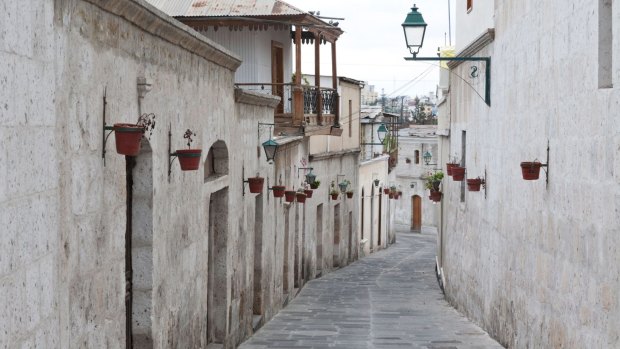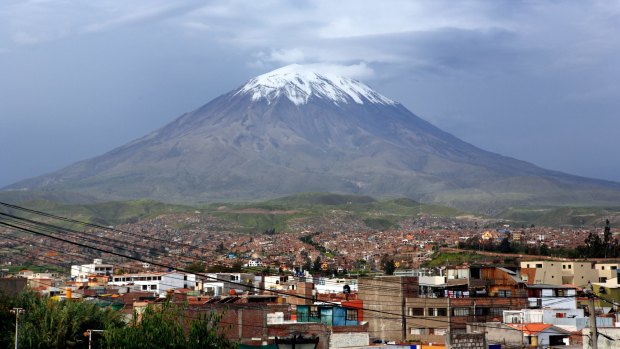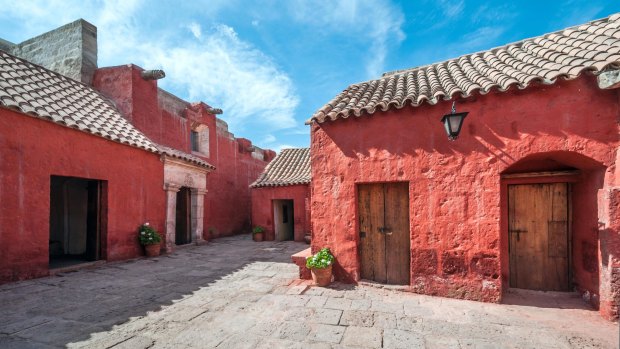This was published 5 years ago
Arequipa: The Peruvian city that's just like one of Europe's finest
By Winsor Dobbin

Colonial architecture in Arequipa, Peru.Credit: Alamy
Peru's second city is often overlooked in favour of more tourist-oriented destinations. That's a huge pity as Arequipa is a wonderfully cosmopolitan and elegant city with colonial buildings reminiscent of some the finest cities of Europe. There are superb squares and alleyways with influences from Spain and Paris, excellent eateries and magnificent viewpoints. It was founded in 1540 and is a great place for strolling and/or chilling out for a few days.
Arequipa was the capital city of Peru from 1835 to 1883 and is today a UNESCO World Heritage site with a combination of architectural styles known as Escuela Arequipeña. It is 2328 metres above sea level and surrounded by a series of volcanic cones: the still active Misti and the extinct cones of Pichu Pichu and Chachani. The western slopes of the Andes are covered in thick layers of volcanic ash.
Arequipa is a city that takes its food seriously and there is the opportunity to sample some stylish Peruvian cuisine in restaurants such as ChiCha and La Benita.

El Misti volcano, seen from Arequipa.Credit: Alamy
Astrid y Gaston is a Lima eatery rated among the top 10 in the world and superstar chef Gaston Acurio, known for his fusion food, has affordable offshoots called ChiCha in both Arequipa and Cusco.
Visit any street market, or local restaurant, and you will be confronted by unfamiliar names and flavours. Arequipa is, quite simply, a foodie delight and a stroll around the central San Camilo market is de rigueur.
Visitors should try indigenous Peruvian ingredients such as chilli peppers of multiple types, beans, native fruits and dozens of varieties of corn. Many of the dishes on offer are a mix of recipes from European and Andean cultures. Muña is one of many unfamiliar superfoods available. Pronounced "moon-ya," the plant grows all over the Andes and is used to treat everything from headaches to altitude sickness; and is often served as a tea.

Santa Catalina monastery, Arequipa.Credit: Alamy
Dishes that visitors will almost certainly find include: ceviche, raw fish marinated in citrus juice, lomo saltado, stir-fried steak with beef or local alpaca; causa, a cold casserole of potatoes and avocado; the chicken stew known as aji de gallina, skewers of marinated meats (usually beef hearts) known as anticuchos; and local Arequipa speciality rocoto rellenos, mildly spicy stuffed peppers. Everywhere you go you'll find stores or market stalls selling pollo al a brasa, roast chicken marinated in soy sauce flavoured with red peppers, garlic and cumin; and tamales, boiled corn with meat or cheese wrapped in a banana leaf.
Pisco is the national drink, made from grape spirit, and Pisco Sours are popular cocktails. They feature citrus juice, eggs whites, sugar syrup and prodigious amounts of pisco. Also try craft brews at Chelawesi and wines from around South America on the balcony at Cafe y Vino wine bar. Arequipa is know as the White City (Ciudad Blanca) because of the colour of many of its houses and buildings, which are made of white ashlar (sillar) volcanic stone.
Be sure to allow time to visit the Santa Catalina Monastery, which was founded in 1579 and is described as "a city within a city". Made from ashlar, the volcanic stone sourced locally, it is considered the most impressive colonial building in the city, with a mixture of colonial Spanish and native architectural styles. It contains a fine gallery of religious art and has changed little over 500 years.
Other major attractions include the Museum of Contemporary Art, which specialises in works by local artists; the Iglesia La Compania de Jesus (a Jesuit church with Baroque facade and chapel), and the traditional districts of Carmen Alto and Yanahuara, with large colonial houses known as casonas.
The city's main square, the Plaza de Armas, contains a beautiful bronze fountain crowned with the figure of a soldier from the 16th century. This square is a good spot to relax away from the hustle and bustle over a cup of coffee.
The Andean Sanctuary Museum on the Santa Maria Catholic University campus contains the slightly gruesome mummified remains of Juanita, a teenage Incan girl sacrificed to the gods nearly 500 years ago. Her remains were revealed when snow melted on a mountain top.
The Colca Canyon, 160 kilometres away, is an interesting day trip or overnight stop, where majestic condors can be seen gliding in the thermals. Belmond Las Casitas del Colca offers a luxury overnight stay. See belmond.com
Note, however, that like many South Americans cities, Arequipa is surrounded by hellish slums such as Ciudad de Dios, ironically City of God, with dusty streets and no running water or sewage system. Visitors are advised to stay away.
Winsor Dobbin travelled as a guest of Contours Travel and LATAM Airlines.
TRIP NOTES
MORE
VISIT
Contours Travel is Australia's most experienced and longest-running Latin American travel wholesaler and agency, specialising in tailor-made, small-group itineraries and special interest tours. See contourstravel.com.au
TOUR
Free guided walking tours of Arequipa are held twice daily; groups meet in front of the Santa Catalina Monastery.
STAY
Casa Andina Premium Hotel Arequipa is in the centre of the city, located in an 18th-century colonial mansion made of volcanic stone. See casa-andina.com/en The Inkanto Hotel (see inkantohotel.com/en) and the Hotel Libertador (see libertador.com.pe) are also good options.
Sign up for the Traveller Deals newsletter
Get exclusive travel deals delivered straight to your inbox. Sign up now.